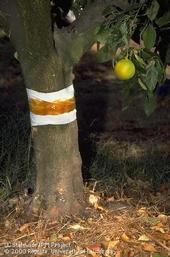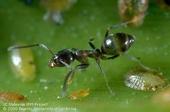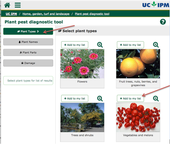
If you have ants climbing up and down trees and shrubs in your landscape, and your trees and shrubs appear to have a sticky substance covering their leaves, you'll want to watch UC IPM's newest YouTube video, “Using a Sticky Barrier to Prevent Ants on Trees and Shrubs”.
The short video explains that the sticky substance on your leaves is honeydew, a sugary substance excreted by aphids, psyllids and a few other plant pests. Ants harvest this...
Using mulch in your garden or landscape helps conserve water and prevent weeds. This new UC IPM video explains how to prepare the site, describes various types of organic mulch available, and demonstrates useful techniques for effective weed control.
For more information on mulch, see the UC IPM website about using mulch in the garden.
See UC IPM's pages on weed identification and control:
- Author: Karey Windbiel-Rojas
![Adult Jerusalem cricket. [A.Antonelli]](https://ucanr.edu/blogs/UCIPMurbanpests/blogfiles/38773small.jpg)
We have received several questions lately from people who've found large, strange looking insects in their garden and landscape. What are these alien-like creatures? Are they good, bad, do they bite?
They are Jerusalem crickets, also sometimes called sand cricket, niña de la tierra (child of the earth), potato bug, and stone cricket.
Jerusalem crickets are relatives of crickets, grasshoppers, and katydids. These large insects can be up to two inches long and have heads that somewhat resemble a human head. Their head and body are amber colored, with dark stripes on the abdomen, long antennae, and no wings. Their thick legs are...

Download the free booklet at the bottom of the page!
1. Ants
Most people deal with ants around their home at some point. Because most ants live outdoors, focus efforts on keeping ants from entering buildings by caulking entryways. Follow good sanitation practices to make your home less attractive to ants. Spraying ants inside the home will not prevent more ants from entering. Use baits to control the ant colony. Pesticide baits work by attracting worker ants who then take the poison back to the nest where the entire colony, including queens, can be killed. In the landscape, ants protect...

UC IPM has created a diagnostic tool to help easily diagnose pest problems in your garden or landscape.
To get started using the tool, you'll first need to identify the affected plant in your landscape. Then, choose one of the four Plant Types categories that best describes it. To do this, click on the photo directly or use the +Add to my list button.
You will know the choice was made when...


